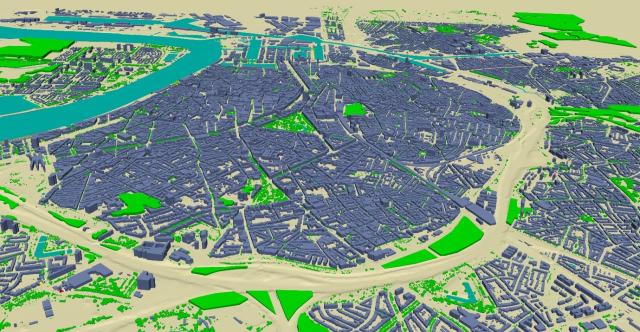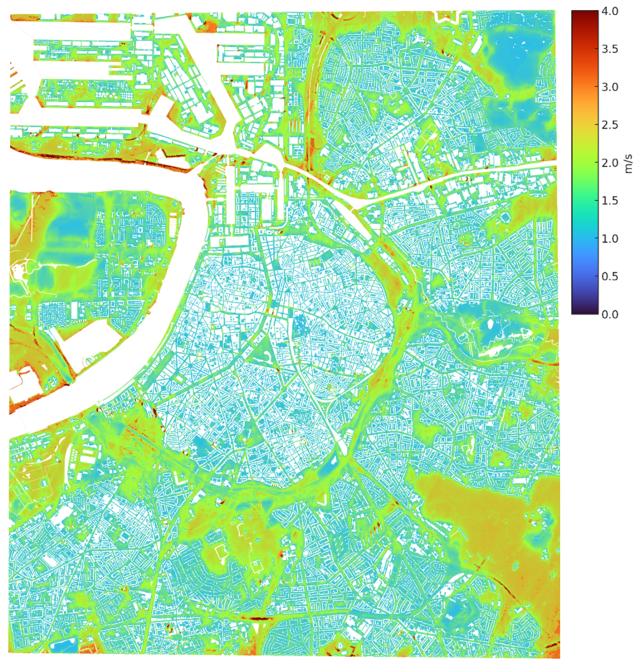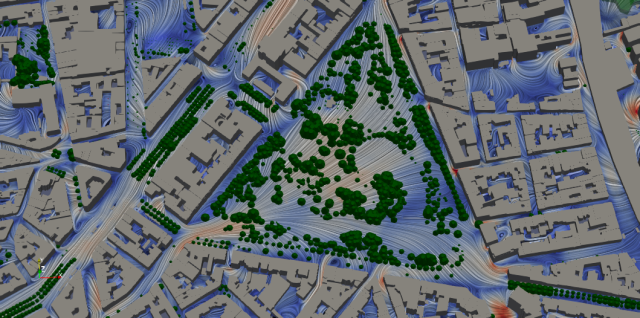ATMO-Flow is a modelling framework based on Computational Fluid Dynamics (CFD) developed by VITO’s ATMOSYS team. It has led to the creation of a unique 3D wind flow model of the entire city of Antwerp. The model covers an area of approximately 9 by 9 km² and provides a detailed picture of the air quality challenges throughout the area with a resolution of 1 metre. The model also allows precise evaluations of wind comfort for all locations in the city and the impact of wind on the urban climate. In addition, the model can be used to assess the potential of urban wind turbines both at ground and roof levels.
Computational Fluid Dynamics
Computational Fluid Dynamics is a method quantifying the motion of fluid flows and assess their impact on the environment. The ATMOSYS team at VITO uses this technology to create 3D models of cities to assess urban air pollution and of complex industrial sites to perform microscale assessments. Additionally, CFD can be used to estimate wind power and evaluate wind comfort.
Thanks to the development of ATMO-Flow, which is a framework of tools that prepares geometries, and manages and processes the widely used CFD software 'OpenFOAM', it is possible to create a high-resolution wind flow model of the entire territory of the city of Antwerp. In addition to the extreme detail, it offers a unique combination of insights in several topics: air quality, wind climate and comfort, wind energy potential and exploration of design options for sustainable cities.
Building footprint and vegetation
Jorge Sousa, air quality modelling researcher at VITO, explains how the model was created. "The basis for the model was the 3D building information of Flanders offered by Digitaal Vlaanderen. This data was supplemented with detailed information on the footprint of each building in Antwerp. The 3D geometrical reconstruction was achieved with the help of tools developed by TU Delft. After that, we have put a lot of effort into accurately determining the current vegetation (location and size) on the entire territory of the city, with a special focus on trees, using Digitaal Vlaanderen’s digital surface and digital terrain models, derived from remote sensing images.”
Air quality
“The CFD modelled air quality maps represent an opportunity for a detailed assessment of the most challenging environments according to the Ambient Air Quality Directive," says Jorge Sousa. "The maps offer great added value for locations such as urban tunnel portals near high-rise buildings, street canyons or industrial sites. It can be used for modelling guided and non-guided emissions, taking into account the 3D characteristics of the industrial site and its surroundings, ideal for a detailed analyses of building downwash, pollutant entrainment and mitigation features."
Wind comfort and power
“In addition to its potential for monitoring and addressing air quality issues, the model also provides high-resolution mapping of wind flows and allows reliable assessments of wind comfort, for example in the vicinity of high-rise buildings," emphasises Jorge Sousa. The ATMOSYS wind comfort analysis is based on the Dutch wind comfort standard NEN 8100, currently the most used standard in the European Union.
At the same time, the map provides an insight into the potential for wind power at rooftops, pedestrian level and at increased height. This responds to the innovative research on wind turbines for use in urban environments.
Last but not least, the maps provide the opportunity to study the impact of wind on the urban climate and to assess the influence of buildings and trees on urban ventilation during heat waves. This has been done in collaboration with VITO’s climate impacts team, a nice example of the multidisciplinary collaboration within VITO.



